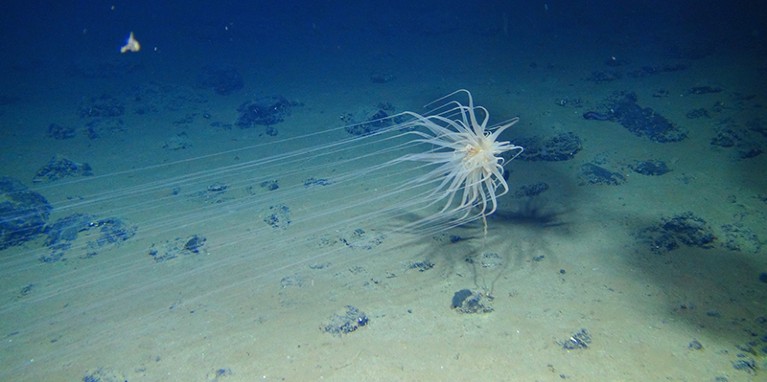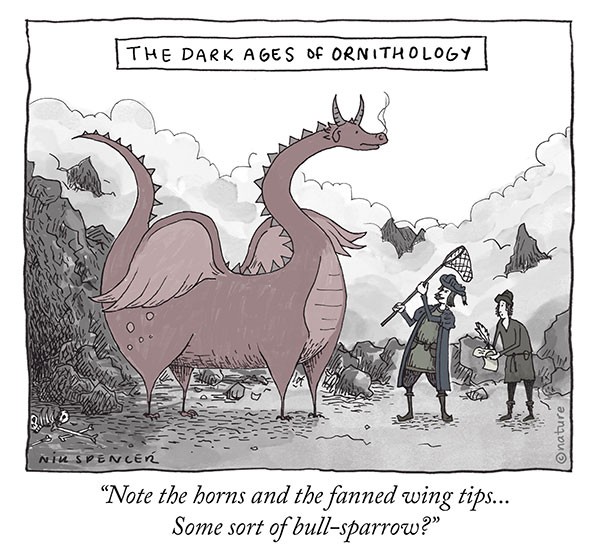Hello Nature readers, welcome to your essential daily round-up of science news.

A new species of the sea-anemone-like Relicanthus clings to a sponge stalk on the floor of the Pacific Ocean.Credit: D. J. Amon & C. R. Smith
Mining threatens area where “researchers are discovering species faster than they can name them”
Shocking discoveries are coming in from the Clarion–Clipperton Zone, thousands of metres deep in the eastern central Pacific Ocean. Among hills and mountains rising across deep undersea plains, the landscape is teeming with life more diverse and abundant than expected. Scientists have also found a fossil graveyard of perhaps six extinct species of whale whose skulls are encrusted in metallic residues. The area has come under fresh scrutiny as companies explore the area for cobalt, manganese and other metals.
Hayabusa2 lands hopping rovers on asteroid
Japan’s Hayabusa2 spacecraft has successfully dropped two rovers onto the asteroid Ryugu. The vehicles will use rotating motors to make slow-motion, 15-minute hops in the asteroid’s low gravity, photographing the surface and measuring its temperature. Hayabusa2 will drop two more landers, and eventually touch the surface itself to collect a sample to bring back to Earth.
DNA connects ivory smugglers to justice
Conservation biologists are analysing the DNA of illegal ivory to uncover Africa’s largest smuggling cartels. Researchers have found that three cartels are responsible for moving most smuggled ivory out of the continent. By linking multiple hauls together, they can connect contraband to its point of origin and show the full extent of the trade — before it’s too late for Africa’s 400,000 remaining elephants.
Reference: Science Advances paper
Octopuses on ecstasy just want a cuddle
Like humans, octopuses become more sociable and engaged after a dose of the party drug MDMA. Researchers submerged five octopuses in MDMA-laced water and tested their behaviour around others of their kind. The findings suggest that serotonin played an important part in social behaviour in the common ancestor of octopuses and vertebrates, whose branches on the family tree separated more than 500 million years ago.
Nature Research Highlights | 1 min read
Reference: Current Biology paper
Get more of Nature’s Research Highlights: short picks from the latest papers.
FEATURES & OPINION
The disaster domino effect
Extreme events are connected. Drought and record temperatures precede deadly wildfires. Charred landscapes are more vulnerable to flooding and landslides. Chains of adverse events such as these, cascading like toppling dominoes, will become more common as the world warms. To plan for the scale and nature of upcoming disasters, we need a framework to understand the risks, argue eight researchers.
The research — and hope — lost in Brazil
The horrific fire that gutted the National Museum in Rio de Janeiro cost the country more than the history embodied in its irreplaceable artefacts. “We lost our present — there were so many master’s-level and doctorate-level research projects going on in there — and we jeopardized part of our future, for a good while,” says social anthropologist Mirani Barros.
Earth’s most ear-opening soundscapes
The shattering-glass sound of lava flowing from Kilauea Volcano in Hawaii and the whispering of the thousands of genetically identical aspen trees, known as the Pando clone, in Utah are among 11 sounds captured in this 30-minute-long audio journey. At each stop, scientists or other local experts introduce these mysterious auditory experiences.
The New York Times Magazine | 30 min listen
QUIRKS OF NATURE

